 MANUFACTURING CAPACITY
Tyler Hart
24 September 2014
Exhibit 99.2 |
 MANUFACTURING CAPACITY
Tyler Hart
24 September 2014
Exhibit 99.2 |
 DISCLAIMER
2
This Management Presentation contains forward-looking statements. James Hardie may from time to
time make forward-looking statements in its periodic reports filed with or furnished to the
SEC, on Forms 20-F and 6-K, in its annual reports to shareholders, in offering circulars, invitation memoranda and prospectuses, in media releases and other written
materials and in oral statements made by the company’s officers, directors or employees to
analysts, institutional investors, existing and potential lenders, representatives of the media
and others. Statements that are not historical facts are forward-looking statements and such
forward-looking statements are statements made pursuant to the Safe Harbor Provisions of
the Private Securities Litigation Reform Act of 1995.
Examples of forward-looking statements include: •
statements about the company’s future performance; •
projections of the company’s results of operations or financial condition; •
statements regarding the company’s plans, objectives or goals, including those relating to
strategies, initiatives, competition, acquisitions, dispositions and/or its products;
•
expectations concerning the costs associated with the suspension or closure of operations at any of
the company’s plants and future plans with respect to any such plants;
•
expectations concerning the costs associated with the significant capital expenditure projects at any
of the company’s plants and future plans with respect to any such projects;
•
expectations regarding the extension or renewal of the company’s credit facilities including
changes to terms, covenants or ratios;
•
expectations concerning dividend payments and share buy-backs; •
statements concerning the company’s corporate and tax domiciles and structures and potential
changes to them, including potential tax charges;
•
statements regarding tax liabilities and related audits, reviews and proceedings; •
statements regarding the possible consequences and/or potential outcome of the legal proceedings
brought against two of the company’s subsidiaries by the New Zealand Ministry of Education
and the potential product liabilities, if any, associated with such proceedings;
•
expectations about the timing and amount of contributions to Asbestos Injuries Compensation Fund
(AICF), a special purpose fund for the compensation of proven Australian asbestos-related
personal injury and death claims;
•
expectations concerning indemnification obligations; •
expectations concerning the adequacy of the company’s warranty provisions and estimates for
future warranty-related costs;
•
statements regarding the company’s ability to manage legal and regulatory matters (including but
not limited to product liability, environmental, intellectual property and competition law
matters) and to resolve any such pending legal and regulatory matters within current estimates and in anticipation of certain third-party recoveries; and
•
statements about economic conditions, such as changes in the US economic or housing recovery or
changes in the market conditions in the Asia Pacific region, the levels of new home
construction and home renovations, unemployment levels, changes in consumer income, changes or stability in housing values, the availability of mortgages and
other financing, mortgage and other interest rates, housing affordability and supply, the levels of
foreclosures and home resales, currency exchange rates, and builder and consumer confidence. |
 3
Words such as “believe,” “anticipate,” “plan,” “expect,”
“intend,” “target,” “estimate,” “project,” “predict,” “forecast,” “guideline,” “aim,” “will,” “should,” “likely,” “continue,”
“may,” “objective,” “outlook” and similar expressions are
intended to identify forward-looking statements but are not the exclusive means of identifying such statements. Readers are
cautioned not to place undue reliance on these forward-looking statements and all such
forward-looking statements are qualified in their entirety by reference to the following
cautionary statements.
Forward-looking statements are based on the company’s current expectations, estimates and
assumptions and because forward-looking statements address future results, events and
conditions, they, by their very nature, involve inherent risks and uncertainties, many of which are unforeseeable and beyond the company’s control. Such known and
unknown risks, uncertainties and other factors may cause actual results, performance or other
achievements to differ materially from the anticipated results, performance or achievements
expressed, projected or implied by these forward-looking statements. These factors, some of which are discussed under “Risk Factors” in Section 3 of the Form
20-F filed with the Securities and Exchange Commission on 26 June 2014, include, but are not
limited to: all matters relating to or arising out of the prior manufacture of products that
contained asbestos by current and former James Hardie subsidiaries; required contributions to AICF, any shortfall in AICF and the effect of currency exchange rate
movements on the amount recorded in the company’s financial statements as an asbestos liability;
governmental loan facility to AICF; compliance with and changes in tax laws and treatments;
competition and product pricing in the markets in which the company operates; the consequences of product failures or defects; exposure to environmental,
asbestos, putative consumer class action or other legal proceedings; general economic and market
conditions; the supply and cost of raw materials; possible increases in competition and the
potential that competitors could copy the company’s products; reliance on a small number of customers; a customer’s inability to pay; compliance with and
changes in environmental and health and safety laws; risks of conducting business internationally;
compliance with and changes in laws and regulations; the effect of the transfer of the
company’s corporate domicile from The Netherlands to Ireland, including changes in corporate governance and any potential tax benefits related thereto; currency
exchange risks; dependence on customer preference and the concentration of the company’s customer
base on large format retail customers, distributors and dealers; dependence on residential and
commercial construction markets; the effect of adverse changes in climate or weather patterns; possible inability to renew credit facilities on
terms favourable to the company, or at all; acquisition or sale of businesses and business segments;
changes in the company’s key management personnel; inherent limitations on internal
controls; use of accounting estimates; and all other risks identified in the company’s reports filed with Australian, Irish and US securities agencies and exchanges (as
appropriate). The company cautions you that the foregoing list of factors is not exhaustive and that
other risks and uncertainties may cause actual results to differ materially from those
referenced in the company’s forward-looking statements. Forward-looking statements speak only as of the date they are made and are statements of the company’s
current expectations concerning future results, events and conditions. The company assumes no
obligation to update any forward-looking statements or information except as required by
law. |
 •
BACKGROUND
•
CAPACITY DIRECTIONAL CONCEPTS
–
LOGIC
–
CURRENT PLAN AND FORECAST
–
NEXT STATE OF MANUFACTURING
•
TACTICAL REVIEW OF CAPITAL PROJECT
AGENDA / KEY TAKE AWAYS
4 |
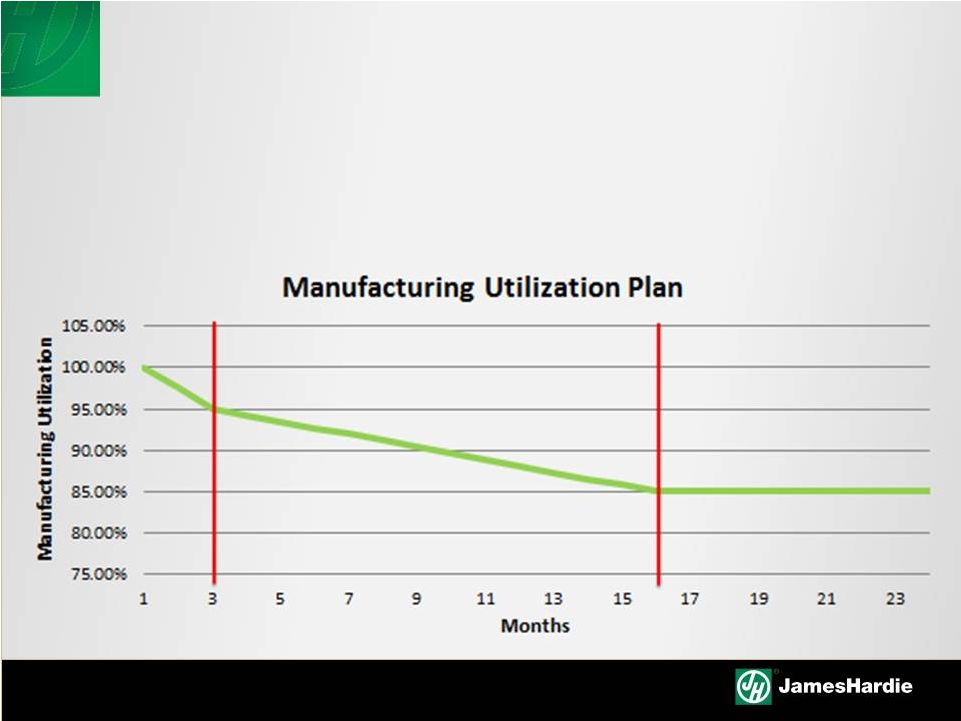 Utilization concept allows for both a short and long term sheet
machine
start
up
capacity
decision
while
allowing
flexibility
to
act
accordingly inside the network.
CAPACITY UTILIZATION LOGIC –
85% OR 95%
5 |
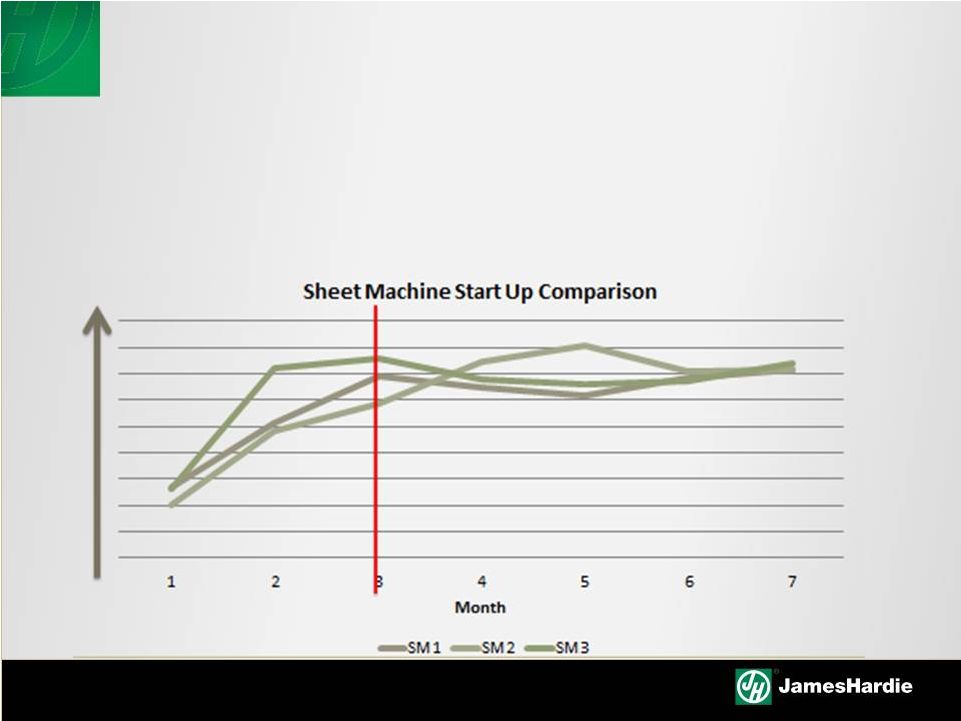 95% Plan –
3 to 6 Months out (Short Term)
•
•
CAPACITY UTILIZATION LOGIC –
85% OR 95%
6
History / Experience on ramp up and utilization
Ramp up effects design and utilization needs |
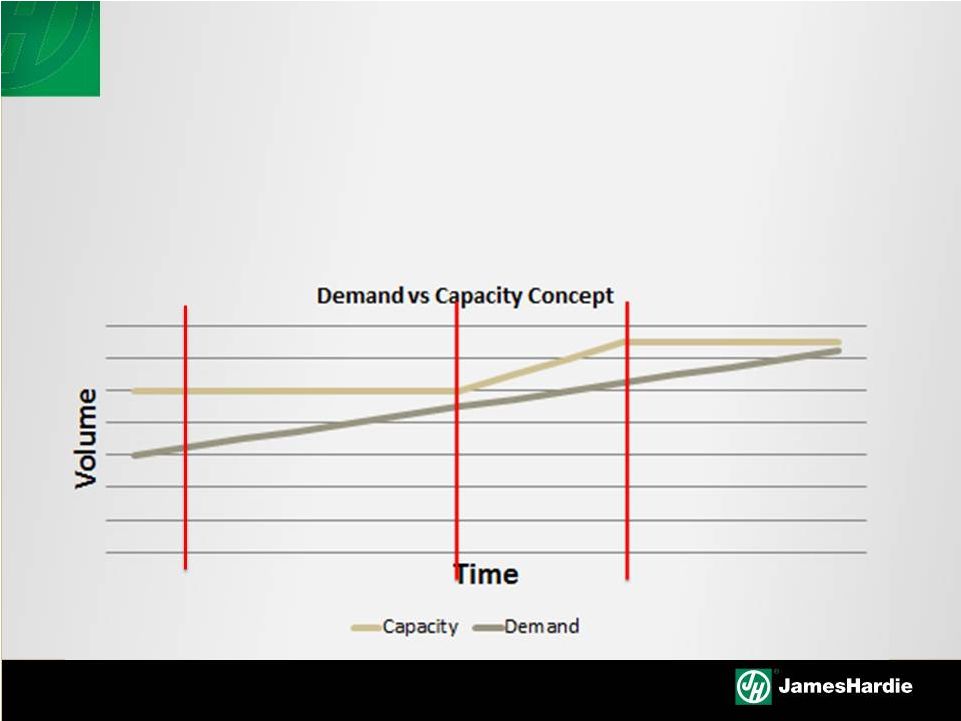 85% Plan –
16 + Months out (Long Term)
•
•
CAPACITY UTILIZATION LOGIC –
85% OR 95%
Start Construction
Start Up
Ramp Up
7
History of Growth
Risk adverse –
Be early rather than late |
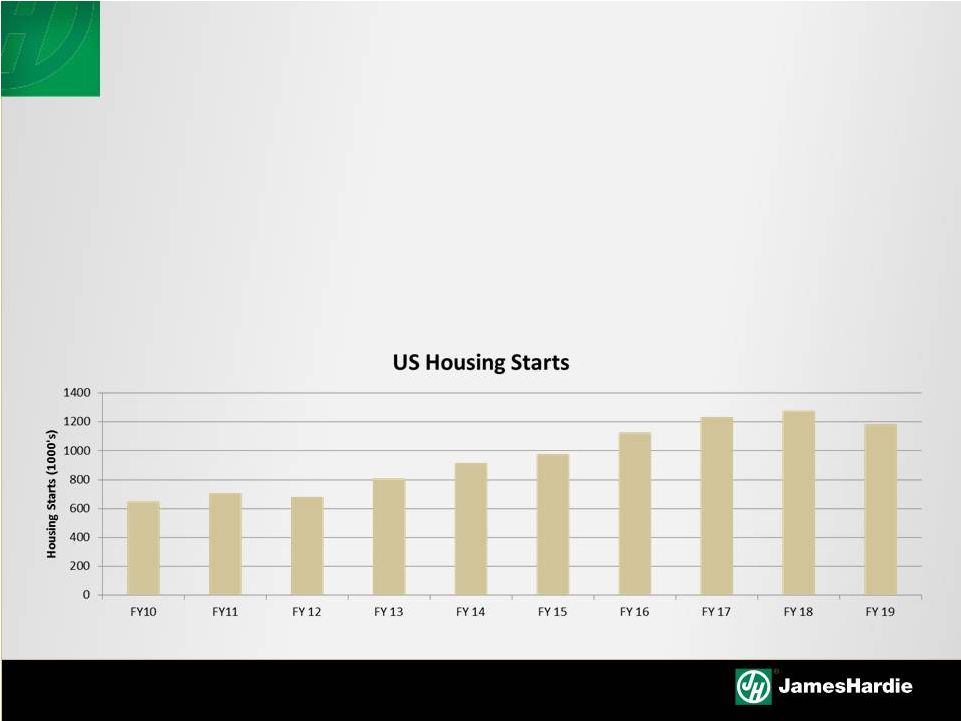 •
Two Key Inputs to Plan
•
James Hardie Growth
–
R&R Growth Rate
–
New Construction Starts
–
James Hardie Market Growth
•
Results
–
US house starts behind plan
–
James Hardie Market Growth at plan
CAPACITY PLANNING LOGIC –
LONG TERM
Dodge New Construction Forecast FY14 –
FY19
8 |
 •
Determines Ideal # of plants
•
Long Term Cost curve =
+
Fixed
+
Freight
+
Capital
+
Inventory
CAPACITY PLANNING LOGIC
•
Inflection point indicates total # of
plants
–
New Additions
•
Summerville
•
Tacoma
•
Green Fields
9 |
 •
BACKGROUND
•
CAPACITY DIRECTIONAL CONCEPTS
–
LOGIC
–
CURRENT PLAN AND FORECAST
–
NEXT STATE OF MANUFACTURING
•
TACTICAL REVIEW OF CAPITAL PROJECT
AGENDA / KEY TAKE AWAYS
10 |
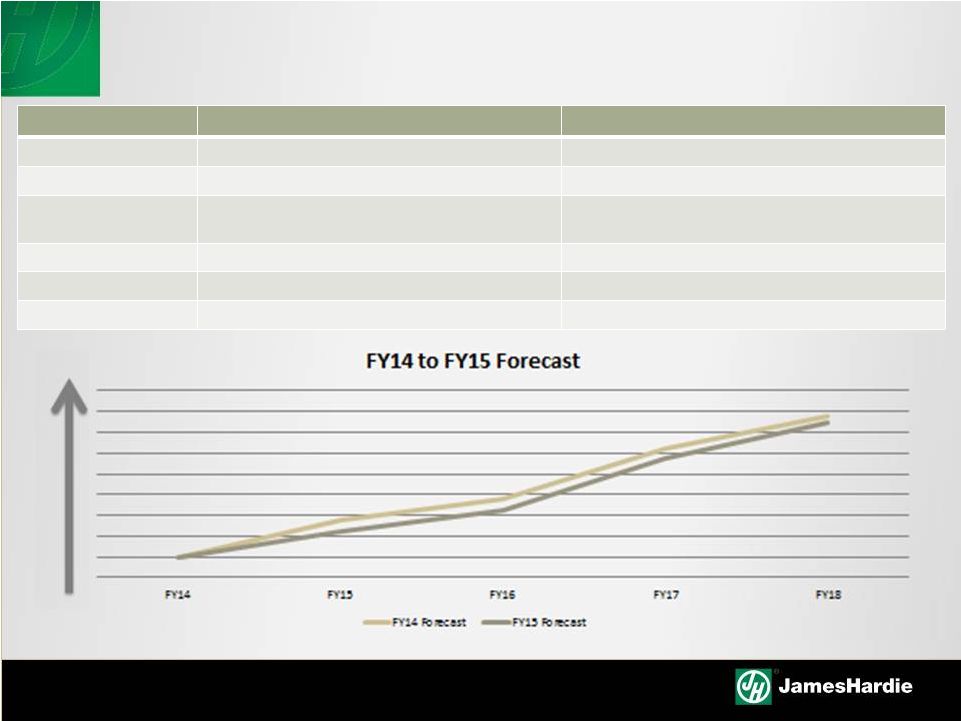 CAPACITY PLAN FY14 AND FY15 GUIDANCE
FY14 PLAN
FY15 Difference to Plan
FY 14
No Additional Capacity
Started Up SM1 Wax
FY 15
Fontana SM1/SM2 and Cleburne
Only need SM2 Fontana
FY16
Cleburne SM3 and PC SM 4 and Trim AC
Cleburne Start Up Dependent on Demand
Schedule
FY17
Tacoma SM2 and Summerville SM1
Tacoma Start Up Dependent on Demand Schedule
FY18
Green Field Capacity
Green Field delayed
FY19
No Guidance
11 |
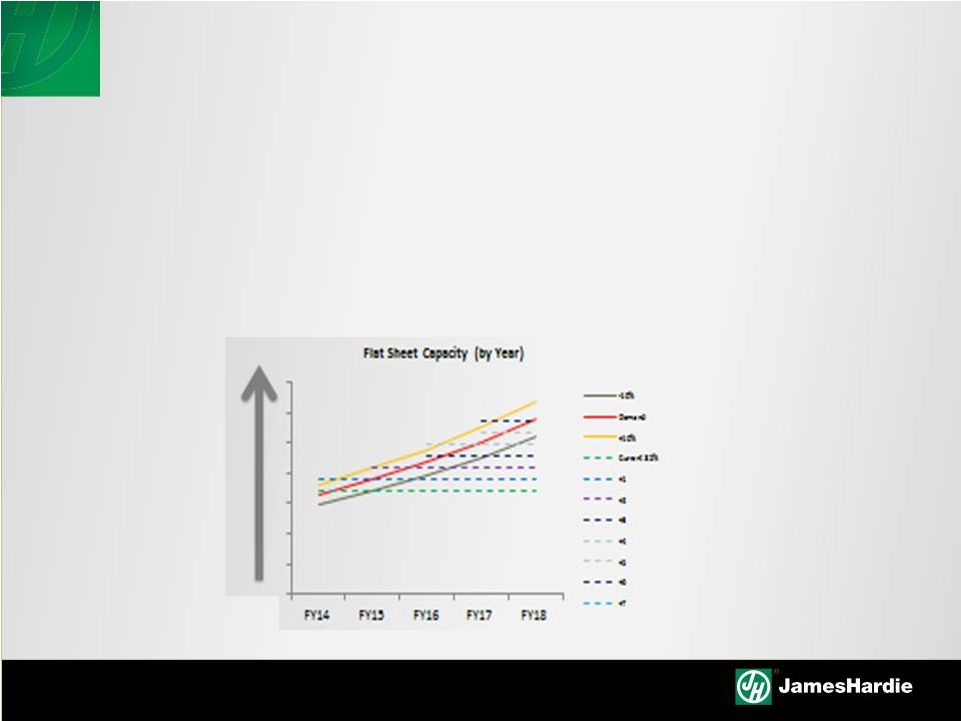 CAPACITY SENSITIVITY
•
Evaluated demand plan with range of ±10%
–
Capacity changes are not influenced by small demand swings
–
Lower demand pushes out 1 yr
–
Higher demand pulls decisions sooner or run above utilization
target
12 |
 CAPACITY EFFICIENCY
Capital $ / Square Feet Produced
•
•
•
Revenue and/or Margin vs Capital $
•
•
13
Good measurement for plank and panel line
Good measurement of Green Field vs Brown Field.
Poor Measurement of specialty products impact on
both capital cost and revenue
Takes into account the impact of higher sales price
for specialty products
Highlights the cost of capital for these specialty products
|
 CAPACITY CONCEPTS SUMMARY
•
Planning is a sliding scale
•
Capacity additions are more weighted today
toward specialty products
•
Capacity additions leads us to optimization to
ensure return on investment
14 |
 •
BACKGROUND
•
CAPACITY DIRECTIONAL CONCEPTS
–
LOGIC
–
CURRENT PLAN AND FORECAST
–
NEXT STATE OF MANUFACTURING
•
TACTICAL REVIEW OF CAPITAL PROJECT
AGENDA / KEY TAKE AWAYS
15 |
 NEXT
STATE OF MANUFACTURING Optimization of capital cost
•
Governmental Influences : Water, Air, Building
•
Current Non Compressible Influences : Water
Discharge, Curing, Raw Materials,
•
Current Compressible Influences : Machine output,
building utilization/line design, labor utilization
16 |
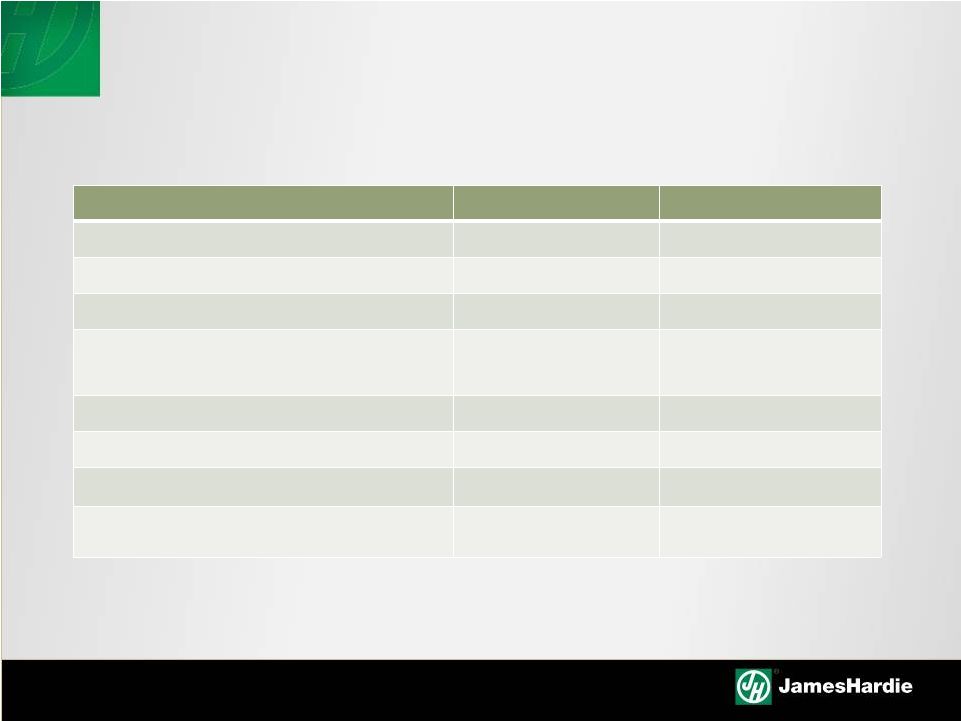 NEXT
STATE OF MANUFACTURING Plant 1
Plant 2
Edge Treatment
Yes
Yes
Top Treatment
Yes
No
Coating Process
1 Coater
2 Coaters
Drying Process
1 Dryer
2 Dryers
Automatic On Loader
Yes
No
Sealers
No
Yes
Building Space (ft^2)
30,000
100,000
# Critical Pieces of Equipment
7
11
Example of Line Design, Building Utilization, Machine output
17 |
 •
BACKGROUND
•
CAPACITY DIRECTIONAL CONCEPTS
–
LOGIC
–
CURRENT PLAN AND FORECAST
–
NEXT STATE OF MANUFACTURING
•
TACTICAL REVIEW OF CAPITAL PROJECT
AGENDA / KEY TAKE AWAYS
18 |
 CAPACITY UPDATE
Capacity expansion plans aligned to current forecast and
our target utilization rate
–
Fontana:
Ramp-up
currently
on
track
–
Plant
City
Trim:
Construction
complete
Q4FY15
–
Cleburne:
Construction
complete
Q1FY16
–
Next
Capacity
Addition:
–
Summerville
FY17
–
Future
Capacity
Additions:
–
Tacoma
and
Green
Field
19 |
 •
Capacity planning is sliding scale relative to market and share growth but
base thought process is the same.
•
The forecast has been reduced in response to slower than expected US
housing recovery
•
Capacity headwinds:
–
Construction cost increase –
offset partially by Brown Field, and
Design efficiency
–
Permitting –
Air, Construction and Water
•
Current capacity additions on track to meet scope and utilization criteria
SUMMARY
20 |
 QUESTIONS |